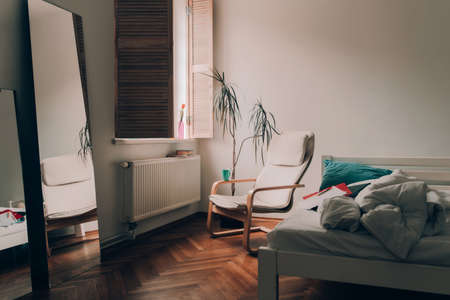Understanding UK Rental Regulations and Flat Painting Etiquette
Before you even think about picking up a paintbrush, it’s crucial to familiarise yourself with the legalities surrounding flat painting in the UK rental market. Renting in the UK comes with a unique set of regulations and cultural norms that every tenant should be aware of. Most tenancy agreements include clauses about alterations and redecorating, which means you’ll likely need written permission from your landlord before making any changes—even if it’s just a fresh coat of paint. Failing to obtain this approval could put your deposit at risk or even breach your contract, so always read your tenancy agreement carefully and communicate openly with your landlord.
When approaching your landlord, being transparent about your intentions and offering reassurances regarding the standard of work can make all the difference. Propose using neutral colours or offer to return the property to its original state when you move out; this is often viewed favourably in British rental culture. Additionally, keep detailed records of correspondence and consider getting written confirmation for any permissions granted. By respecting these etiquette points and adhering to legal requirements, you not only protect your deposit but also maintain a positive relationship with your landlord—a win-win situation for both parties.
Choosing the Right Paint for British Homes
When it comes to painting your flat in the UK, selecting the right paint is as crucial as your brushwork. Britain’s unique climate—think frequent rain, humidity, and fluctuating temperatures—demands paints with durability and resilience. Moreover, many British homes have historical features or period details, requiring a thoughtful approach to both colour and finish. Let’s explore how to make smart choices for long-lasting, stylish results that suit the British context.
Understanding Paint Types for the UK Climate
Not all paints are created equal. In the UK, moisture resistance is key, especially in older properties where damp can be an issue. Opting for paints designed specifically for high humidity rooms (like kitchens and bathrooms) or washable emulsions for busy areas will ensure longevity. For those living in heritage flats, breathable paints are often recommended to allow walls to “breathe” and prevent trapped moisture.
Popular Paint Finishes and Their Benefits
| Finish Type | Best For | Key Benefits |
|---|---|---|
| Matte/Flat Emulsion | Living rooms, bedrooms | Masks imperfections; soft, modern look; aligns with minimalist British interiors |
| Satin/Silk Emulsion | Hallways, children’s rooms | More durable and wipeable; subtle sheen suits contemporary spaces |
| Eggshell | Period properties, woodwork | Slight sheen; traditional aesthetic; easier to clean than matte finishes |
| Gloss | Skirting boards, doors | Highly durable; classic British trim finish; easy to maintain |
The Allure of Heritage Colours and Modern Trends
A defining element of British interior design is the use of heritage colours—think muted greens, deep blues, and warm neutrals inspired by historic country houses. Many leading UK paint brands offer heritage ranges that are perfect for period flats or those wanting a timeless feel. For a more contemporary look, consider cool greys or bold feature walls in jewel tones—trends that have swept across British cities from London to Manchester.
Matching Paint Choices with Your Flat’s Character
If you’re updating a Victorian conversion or a mid-century council flat, let your property’s architecture guide you. Classic whites and creams keep things airy in small spaces typical of city flats, while statement ceilings in darker hues can add drama without overwhelming period cornicing or mouldings. Don’t forget: always test paint samples on your wall first—the UK’s shifting light can dramatically alter how colours appear throughout the day.

3. Budget-Friendly Preparation: British DIY Essentials
Before you even open a tin of paint, proper preparation is the backbone of a professional-looking finish – and it doesn’t have to cost the earth. In true British fashion, prepping your flat can be both economical and efficient with a few clever tricks and some classic local know-how.
Where to Buy Affordable Supplies
Start by heading to trusted high street favourites like B&Q, Wickes, or Homebase, where you’ll often find multi-buy deals on brushes, rollers, and trays. For those who prefer online shopping, Screwfix and Toolstation are renowned for value packs and next-day delivery. Don’t overlook local independent hardware shops or charity shops either – they can be treasure troves for gently-used tools or surplus paint at a fraction of the price.
Classic British DIY Tools You Can’t Skip
No prep kit is complete without dust sheets – a staple in any UK home improvement project. Old bedsheets work perfectly well if you’re watching your pennies, but polythene sheets from Poundland are another budget-friendly option for protecting carpets and furniture from rogue paint splatters.
The Magic of Sugar Soap
Ask any seasoned Brit about prepping walls and they’ll mention sugar soap. This affordable cleaning solution cuts through years of grime and grease, ensuring your paint adheres flawlessly. Available in spray bottles or concentrated form at most supermarkets and DIY stores, a little goes a long way – simply dilute as instructed and wipe down all surfaces before painting.
By embracing these British essentials and shopping smartly, you’ll set yourself up for decorating success without overspending. It’s all about resourcefulness: borrow what you can, repurpose what you have, and invest only where it truly counts for that stunning flat transformation.
4. Step-by-Step Painting Techniques for Stunning Results
If you’re aiming to give your flat a fresh look without blowing the budget, mastering the basics of painting is key—and there’s nothing quite like a British approach to detail and finish. From prepping your surfaces to getting those skirting boards just right, let’s break down each step so you can achieve a professional standard at home.
Preparation: The Unsung Hero
As any seasoned decorator in the UK will tell you, a flawless paint job starts with solid preparation. Clear your space, lay down dust sheets (old newspapers work a treat), and fill any cracks or holes with Polyfilla. Lightly sand surfaces for a smooth base, then wipe away dust with a damp cloth. Don’t forget to mask off sockets, switches, and trims using painter’s tape—this ensures crisp edges that really make your handiwork stand out.
The Right Tools for the Job
Selecting quality tools is half the battle won. Here’s a quick guide to typical British painting tools and their uses:
| Tool | Best For |
|---|---|
| Angled Brush | Cutting in along ceilings and skirting boards |
| Roller (Medium Pile) | Main wall areas, especially on textured plaster |
| Small Detail Brush | Trims, window sills, and tight corners |
| Pole Extension | Tall walls or ceilings without ladders |
Classic Techniques with a British Flair
Skirting Boards & Trims
Start with trims using an angled brush for precision. Two coats are ideal—let each dry thoroughly before applying the next. For that distinctively sharp British finish, peel back painter’s tape while the paint is still slightly tacky.
Walls: From Top to Bottom
Always begin at the top and work your way down. Use a roller in ‘W’ or ‘M’ motions for even coverage—a little trick favoured by decorators across the UK to avoid streaks. Feather out edges to blend seamlessly between sections.
Feature Walls: Make It Pop
If you fancy adding character with a feature wall (a classic trend in many London flats), use bold colours or subtle textures. Mark boundaries with tape, and take your time—two thin coats give more depth than one thick application.
Drying Times & Finishing Touches
Don’t rush! In our often-damp British climate, allow ample drying time between coats—typically 4–6 hours, but check your tin’s guidance. Once finished, remove all tape, touch up any blemishes, and step back to admire your handiwork.
Handy British Tip:
If using water-based paints, clean brushes straight away under the tap; if oil-based, white spirit does the trick. Dispose responsibly at your local council facility—doing your bit for Blighty as well as your home!
5. Small Space Solutions: Making the Most of Your Flat
If you’re living in a compact UK flat, you’ll know that every inch counts—especially when it comes to decorating. Painting is one of the most effective and affordable ways to transform your space, but it’s also easy to make a small room feel even smaller if you don’t approach it with care. Here are some expert tips tailored to British flats, helping you use light, colour, and layout to create a sense of spaciousness without breaking the bank.
Light Colours for an Airy Ambience
Choosing the right paint shade can work wonders in opening up your flat. Soft whites, gentle greys, and pale blues are all classic choices beloved in UK interiors for their ability to reflect natural light—even on those typically overcast British days. Lighter tones help bounce sunlight around the room, making spaces feel brighter and less confined. Don’t shy away from subtle pastels either; they’re a contemporary way to add personality while maintaining openness.
Clever Use of Colour Blocking
Colour blocking isn’t just for fashion—it’s a clever design trick for small flats as well. Try painting one wall a slightly deeper tone than the others; this creates depth and draws the eye outward, giving the illusion of more space. For an on-trend British touch, consider muted greens or dusty pinks as accent walls—both add warmth without overwhelming the room.
Maximising Layout with Paint
Think beyond just the walls. Painting woodwork (like skirting boards and door frames) in a crisp white can frame your rooms elegantly and visually extend your floor area. If your ceiling feels low—a common feature in many older UK flats—paint it a shade lighter than your walls to create vertical lift. And don’t forget alcoves: painting them in a contrasting yet harmonious colour adds dimension without clutter.
Practical Application Tips
To get the best results, use high-quality rollers for smooth finishes and always start with proper preparation—cleaning surfaces and applying primer where needed ensures longevity. In tight spaces, opt for quick-drying, low-odour paints so you can get back to enjoying your home sooner rather than later. With these savvy choices and techniques, even the smallest London studio or Edinburgh tenement can feel invitingly spacious and uniquely yours.
6. Aftercare and Sustainable Disposal
Keeping Your Walls Pristine
Once you’ve put in the effort to transform your flat, it’s worth taking a few simple steps to keep those freshly painted walls looking immaculate. Avoid hanging heavy frames or sticky hooks for at least two weeks, as paint needs time to cure fully. For everyday marks, gently wipe with a soft damp cloth — avoid harsh chemicals which can strip away colour or finish. Dust regularly using a microfibre cloth, especially around skirting boards and corners where debris tends to gather in British homes.
Touch-ups: Be Prepared
Save a small pot of leftover paint, clearly labelled with the room and date, for quick touch-ups. Store it in a cool, dry cupboard (the airing cupboard is ideal in UK flats), away from direct sunlight and frost. This way, if scuffs or chips appear, you can swiftly restore your walls without hunting for the exact shade later on.
Sustainable Paint and Material Disposal
Leftover paint and decorating materials shouldn’t go in your regular household bin. Across the UK, local councils provide specific guidance and facilities for responsible disposal. Most Household Waste Recycling Centres accept water-based paints; oil-based varieties may require special handling due to their hazardous nature. Always check your council’s website for up-to-date advice.
Top Tips for Green Disposal:
- If you have usable leftover paint, consider donating it to community projects via schemes like Community RePaint.
- Let empty tins dry out completely before recycling them with metals – lids off!
- Brushes and rollers can be cleaned and reused; choose eco-friendly detergents when washing up.
A Final Word
With mindful maintenance and sustainable disposal practices, you’ll not only extend the life of your beautiful new walls but also do your bit for the environment — all part of making your UK flat both stylish and responsible.


